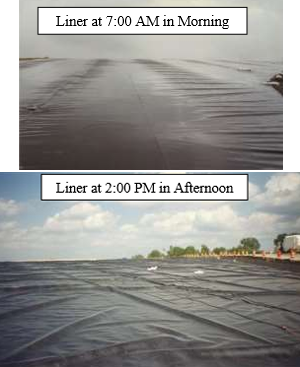
The Geosynthetic Institute (GSI) has long played an important role in the geosynthetics field through research initiatives, educational outreach, conference hosting, standards contributions, and much more. The GSI White Papers archive—28 of which have been published publicly—provides an exceptional platform for information exchange and the promotion of valuable discussion in the discipline. June’s brace of papers are worth exploring side-by-side and continue the Institute’s tradition of keeping the field discussion lively.
White Paper #27 (published 6 June 2013) and White Paper #28 (published 17 June 2013) form a two-part series on the impacts of temperature on geomembranes, with #27 addressing “Intimate Contact” and wrinkles and #28 addressing freeze-thaw cycles. Both phenomena are, of course, temperature related.
Here is a synopsis of the work with PDF download links.
White Paper #27
“The Intimate Contact Issue of Field Placed Geomembranes with Respect to Wave (or Wrinkle) Management”
What happens to a geomembrane and its installation when waves/wrinkles have been “entombed” in the liner during the process of backfilling? Suffice it to say: something does happen to it and, more troubling, quite a lot might happen to it.
White Paper #27 sets out to summarize roughly 20 years of discussion into the impact of wrinkles on a geomembrane’s service life integrity.
“It is well known that the waves are caused by elevated temperatures (in comparison to the geomembrane temperatures at placement and seaming) and are fundamentally related to the type of geomembrane resin as well as its stiffness and thickness,” write GSI’s Robert Koerner and George Koerner.
The authors summarize not just important contributions to the debate (such as Te Yang-Soong’s studies published in 1998 and 1999) but state regulations/perspectives on the need for intimate contact between a geomembrane and the subgrade. Also, they have surveyed international agencies and experts for concerns on wrinkles/waves in buried geomembranes.
For the white paper authors, the biggest concern is that waves entombed in a geomembrane “create stress concentrations and could possibly decrease the geomembrane’s lifetime.”
Not only is the impact on service life of importance for environmental protection, the economics of lined infrastructure are at stake. Even in 1996 methods of wave repair could cost 10 times as much as the installation might if greater concern was shown to prevent entombing waves.
They write:
Thus, at the heart of a transition to a no-entombed wave strategy is a regulatory requirement followed by an unequivocal statement in the construction quality assurance document for the field inspectors to follow. In the end, however, a “no wave” strategy will result in a greatly improved environmentally safe and secure liner system.
Download a copy of White Paper #27 here (PDF)
White Paper #28:
“Cold Temperature and Free-Thaw Cycling Behavior of Geomembranes and Their Seams”
In the introduction, GSI notes that this particular white paper has been motivated by repeated inquiries regarding “the potential negative effects on the tensile strength of geomembranes and their seams under cold temperature and cyclic freeze-thaw field conditions.”
The paper, as such, serves largely as a way to explain why these questions cannot be answered simply; at least, with any site/project-specific relevancy.
The paper has three co-authors: GSI’s George Koerner and Grace Hsuan and Alice Comer (formerly of the US Bureau of Reclamation). Comer and Hsuan’s joint EPA-BuRec work in this area (1996) serves as the base for the white paper’s research with the team contributing updates from the 17 years since that important work.
The difficulty in compartmentalizing the information is apparent. The authors cite notable works on cold temperature impacts and freeze-thaw cycles going back to the mid-1970s. While the results were clear, to apply previous studies across differing geomembrane polymer types would not be accurate.
“Individual testing is required due to the uniqueness of each polymer type and its specific formulation. Additives such as plasticizers, fillers, antioxidants, carbon black, colorants, etc., can influence the results to varying degrees,” the authors note. “Even the resins themselves have behavioral differences at different temperatures”
In summarizing the field’s involvement in this study and revisiting Hsuan and Comer’s EPA-BuRec study, the case for individual tests—material and site specific—becomes pretty clear.
Despite 40 years worth of information cited in the paper, it is concise and accessible, and it ends sharply:
The recommendation reached for this part of the white paper is that if a formulation-specific geomembrane under site-specific conditions is to be evaluated for its stress-versus-strain response, actual tests must be commissioned accordingly. The literature can only give general trends in this regard.
Download a copy of White Paper #28 here (PDF)
– Chris Kelsey is the editor of Geosynthetica. He can be reached at chris@geosynthetica.net.











